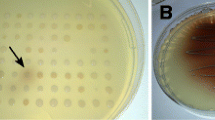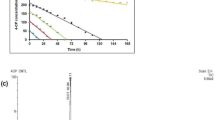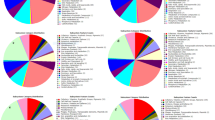Abstract
Metagenomic library construction using a marine sediment-enrichment was employed in order to recover tellurium from tellurite, a tellurium oxyanion, dissolved in water and then functional screening was performed to discover a novel gene related to tellurite reduction. Transmission electron microscopy (TEM) revealed the formation of intracellular Te crystals in Escherichia coli cells transformed with a specific DNA fragment from the marine sediment metagenome. The metagenome fragment was composed of 691 bp and showed low homology to known proteins. Phylogenetic analysis suggested that the metagenome fragment was related to Pseudomonas stutzeri. Cloning and expression of an open reading frame (ORF) on the metagenome fragment validated the role of the fragment in conferring tellurite resistance and tellurite-reducing activity to E. coli host cells. E. coli transformant containing the ORF1 showed resistance to 1 mM Na2TeO3. The optimal tellurite-reducing activity of cells containing the ORF1 was recorded at 37 °C and pH 7.0.








Similar content being viewed by others
Change history
09 November 2020
A Correction to this paper has been published: https://doi.org/10.1007/s10126-020-10008-1
References
Altschul SF, Gish W, Miller W, Myers EW, Lipman DJ (1990) Basic local alignment search tool. J Mol Biol 215:403–410
Arenas-Salinas M, Perez JI, Morales W, Pinto C, Diaz P, Cornejo FA et al (2016) Flavoprotein-mediated tellurite reduction: structural basis and applications to the synthesis of tellurium-containing nanostructures. Front Microbiol 7:1–14
Avazeri C, Turner R, Pommier J, Weiner J, Giordano G, Vermeglio A (1997) Tellurite reductase activity of nitrate reductase is responsible for the basal resistance of Escherichia coli to tellurite. Microbiology 143:1181–1189
Berlemont R, Jacquin O, Delsaute M, La Salla M, Georis J et al (2013) Novel cold-adapted esterase MHIip from an Antarctic soil metagenome. Biology 2:177–188
Borghese R, Baccolini C, Francia F, Sabatino P, Turner RJ, Zannoni D (2014) Reduction of chalcogen oxyanions and generation of nanoprecipitates by the photosynthetic bacterium Rhodobacter capsulatus. J Hazard Mater 269:24–30
Burgess JG, Miyashita H, Sudo H, Matsunaga T (1991) Antibiotic production by the marine photosynthetic bacterium Chromatium purpuratum NKPB 031704: localization of activity to the chromatophores. FEMS Microbial Lett 84:301–306
Calderón IL, Arenas FA, Pérez JM, Fuentes DE, Araya MA, Saavedra CP et al (2006) Catalases are NAD(P)H-dependent tellurite reductases. PLoS One 1(1):70
Castro ME, Molina R, Díaz W, Pichuantes SE, Vásquez CC (2008) The dihydrolipoamide dehydrogenase of Aeromonas caviae ST exhibits NADH-dependent tellurite reductase activity. Biochem Biophys Res Commun 375:91–94
Chasteen TG, Fuentes DE, Tantalean JC, Vasquez CC (2009) Tellurite: history, oxidative stress, and molecular mechanisms of resistance. FEMS Microbiol Rev 33:820–832
Coker VS, Byrne JM, Telling ND, van der Laan G, Lloyd JR, Hitchcock AP et al (2012) Characterization of the dissimilatory reduction of Fe (III)-oxyhydroxide at the microbe-mineral interface: the application of STXM-XMCD. Geobiology 10(4):347–354
Edwards JL, Smith DL, Connolly J, McDonald JE et al (2010) Identification of carbohydrate metabolism genes in the metagenome of a marine biofilm community shown to be dominated by Gammaproteobacteria and Bacteroidetes. Genes 1:371–384
Fan J, Jiang D, Zhao YL, Zhang XC (2014) Crystal structure of lipid phosphatase Escherichia coli phosphatidylglycerophosphate phosphatase B. Proc Natl Acad Sci U S A 111(21):7636–7640
Fujita M, Sakai R (2014) Production of Avaroferrin and Putrebactin by heterologous expression of a deep-sea metagenomic DNA. Mar Drugs 12:4799–4809
Gasteiger E, Gattiker A, Hoogland C, Ivanyi I, Appel RD, Bairoch A (2003) ExPASy: the proteomics server for in-depth protein knowledge and analysis. Nucleic Acids Res 31:3784–3788
Ghachi ME, Howe N, Auger R, Lambion A, Guiseppi A, Delbrassine F, Manat G, Roure S, Peslier S, Sauvage E, Vogeley L, Rengifo-Gonzalez JC, Charlier P, Mengin-Lecreulx D, Foglino M, Touzé T, Caffrey M, Kerff F (2017) Crystal structure and biochemical characterization of the transmembrane PAP2 type phosphatidylglycerol phosphate phosphatase from Bacillus subtilis. Cell Mol Life Sci 74(12):2319–2332
Hill SM, Jobling MG, Lloyd BH, Strike P, Ritchie DA (1993) Functional expression of the tellurite resistance determinant from the IncHI-2 plasmid pMER610. Mol Gen Genet 241:203–212
Iravani S (2014) Bacteria in nanoparticle synthesis: current status and future prospects. Int Sch Res Notices 2014:1–18
Jiang CJ, Hao ZY, Zeng R, Shen PH, Li JF, Wu B (2011) Characterization of novel serine protease inhibitor gene from a marine metagenome. Mar Drugs 9:1487–1501
Jobling MG, Ritchie DA (1987) Genetic and physical analysis of plasmid genes expressing inducible resistance of tellurite in Escherichia coli. Mol Gen Genet 208:288–293
Jobling MG, Ritchie DA (1988) The nucleotide sequence of a plasmid determinant for resistance to tellurium anions. Gene 66:245–258
Kimura M (1980) A simple method for estimating evolutionary rate of base substitutions through comparative studies of nucleotide sequences. J Mol Evol 16:111–120
Klaus-Joerger T, Joerger R, Olsson E, Granqvist C (2001) Bacteria as workers in the living factory: metal-accumulating bacteria and their potential for materials science. Trends Biotechnol 19(1):15–20
Korbekandi H, Iravani S, Abbasi S (2009) Production of nanoparticles using organisms. Crit Rev Biotechnol 29(4):279–306
Kumar S, Stecher G, Tamura K (2016) MEGA7: molecular evolutionary genetics analysis version 7.0 for bigger datasets. Mol Biol Evol 33(7):1870–1874
Liu FL, Yang XL (2017) Indole derivatives produced by the metagenome genes of the Escherichia coli-harboring marine sponge Discodermia calyx. Molecules 22:68–689
Lovley DR (1993) Dissimilatory metal reduction. Annu Rev Microbiol 47:263–290
Mai Z, Su H, Zhang S (2016) Characterization of a metagenome-derived β-glucosidase and its application in conversion of polydatin to resveratrol. Catalyst 6:35–47
Maltman C, Donald LJ, Yurkov V (2017) Tellurite and Tellurate reduction by the aerobic anoxygenic phototroph Erythromonas ursincola strain KR99 is carried out by a novel membrane associated enzyme. Microorganisms 5(2):20
Moore M, Kaplan S (1992) Identification of intrinsic high-level resistance to rare-earth oxides and oxyanions in members of the class Proteobacteria: characterization of tellurite, selenite, and rhodium sesquioxide reduction in Rhodobacter sphaeroides. J Bacteriol 174:1505–1514
Munar MP, Matsuo T, Kimura K, Takahashi T, Okamura Y (2018) Biomineralization of metallic tellurium by bacteria isolated from deep marine sediment in Niigata Bay Japan. In: Endo K et al (eds) Biomineralization. Springer, Berlin, pp 291–301
Narayanan KB, Sakthivel N (2010) Biological synthesis of metal nanoparticles by microbes. Adv Colloid Interf Sci 156(1–2):1–13
Neuwald AF (1997) An unexpected structural relationship between integral membrane phosphatases and soluble haloperoxidases. Protein Sci 6:1764–1767
Okamura Y, Kimura T, Yokouchi H, Meneses-Osorio M, Katoh M, Matsunaga T, Takeyama H (2010) Isolation and characterization of a GDSL esterase from the metagenome of a marine sponge-associated bacteria. Mar Biotechnol 12(4):395–402
Pérez JM, Calderón IL, Arenas FA, Fuentes DE, Pradenas GA, Fuentes EL et al (2007) Bacterial toxicity of potassium tellurite: unveiling an ancient enigma. PLoS One 2:2
Pugin B, Cornejo FA, Muñoz-Diaz P, Muñoz-Villagran CM et al (2014) Glutathione reductase-mediated synthesis of tellurium-containing nanostructures exhibiting antibacterial properties. Appl Environ Microbiol 80(22):7061–7070
Taylor DE (1999) Bacterial tellurite resistance. Trends Microbiol 7:111–115
Taylor DE, Rooker M, Keelan M, Ng LK, Martin I, Perna NT, Burland NTV, Blattner FR (2002) Genomic variability of O islands encoding tellurite resistance in enterohemorrhagic Escherichia coli O157:H7 isolates. J Bacteriol 184:4690–4698
Thompson JD, Higgins DG, Gibson TJ (1994) CLUSTALW: improving the sensitivity of progressive multiple sequence alignment through sequence weighting, position-specific gap penalties and weight matrix choice. Nucleic Acids Res 22(22):4673–4680
Tucker FL, Walper JF, Appleman MD, Donohue J (1962) Complete reduction of tellurite to pure tellurium metal by microorganisms. J Bacteriol 83:1313–1314
Turner RJ, Aharonowitz Y, Weiner JH, Taylor DE (2001) Glutathione is a target in tellurite toxicity and is protected by tellurite resistance determinants in Escherichia coli. Can J Microbiol 47:33–40
Villamizar GAC, Nacke H, Griese L, Tabernero L et al (2019) Characteristics of the first protein tyrosine phosphatase with phytase activity from a soil metagenome. Genes 10:101–117
Whelan KF, Colleran E, Taylor DE (1995) Phage inhibition, colicin resistance, and tellurite resistance are encoded by a single cluster of genes on the IncHI1 plasmid R478. J Bacteriol 177:5016–5027
Yanisch-Perron C, Vieira J, Messing J (1985) Improved M13 phage cloning vectors and host strains: nucleotide sequences of the M13mpl8 and pUC19 vectors. Gene 33(1):103–119
Yurkov VV, Beatty JT (1998) Aerobic anoxygenic phototrophic bacteria. Microbiol Mol Biol Rev 62(3):695–724
Zhang Y, Yang Z, Huang X, Peng J, Fei X, Gu S et al (2008) Cloning, expression, and characterization of a thermostable PAP2L2, a new member of the type-2 phosphatidic acid phosphatase family from Geobacillus toebii T-85. Biosci Biotechnol Biochem 72(12):3134–3141
Acknowledgments
The marine sediment sample was generously provided by Dr. Takeshi Terahara of the Tokyo University of Marine Science and Technology, Japan.
Funding
This work was supported by the research budgets of Hiroshima University. Madison Munar received financial support for his Ph.D. from the Top Global University Project Scholarship of the Ministry of Education, Culture, Sports, Science, and Technology (MEXT) Japan.
Author information
Authors and Affiliations
Ethics declarations
Conflict of Interest
The authors declare that they have no conflict of interest.
Additional information
Publisher’s Note
Springer Nature remains neutral with regard to jurisdictional claims in published maps and institutional affiliations.
Electronic Supplementary Material
Supplementary Figure 1
(PPTX 39 kb)
Rights and permissions
About this article
Cite this article
Munar, M.P., Takahashi, H. & Okamura, Y. Discovery of a Novel Gene Conferring Tellurite Tolerance Through Tellurite Reduction to Escherichia coli Transformant in Marine Sediment Metagenomic Library. Mar Biotechnol 21, 762–772 (2019). https://doi.org/10.1007/s10126-019-09922-w
Received:
Accepted:
Published:
Issue Date:
DOI: https://doi.org/10.1007/s10126-019-09922-w




